ISSN ONLINE(2278-8875) PRINT (2320-3765)
ISSN ONLINE(2278-8875) PRINT (2320-3765)
K.Latha1, Y.V.B.Reddy2, A.M.Prasad3 and K.Veeraswamy4
|
| Related article at Pubmed, Scholar Google |
Visit for more related articles at International Journal of Advanced Research in Electrical, Electronics and Instrumentation Engineering
A coupled feed printed mono pole antenna with low profile yet covering the three LTE, four GSM, and UMTS band operation in the mobile phone is presented. Wideband operation with low profile is possible by exciting the monopole’s wide radiating plate using coupled feed and short-circuiting it to the system ground plane of the mobile phone through a long meandered strip as an inductive shorting strip. The coupling feed contributes to a wide operating band to cover the frequency range of 1710 to 2690 MHz for the GSM 1800/1900/UMTS/LTE2300/LTE2500 operation. The inductive strip and dual band behaviour results in the generation of a wide operating band to cover the frequency range of 698 to 988 MHz for LTE-700, GSM-850, GSM-900. The planar monopole can be directly printed on the bottom no-ground portion of the system circuit board of the mobile phone and is promising to be integrated with a practical loudspeaker. The proposed antenna, including its planar and folded structures, are suitable for slim mobile phone applications.
Keywords |
| coupling feed, inductive shorting strip, printed monopole. |
INTRODUCTION |
| Printed monopoles with a wide radiating strip are simple in design and have been shown to generate wideband operation for the multiband WWAN (wireless wide area network) communications for mobile phone applications. However, in order to cover the lower GSM bands, the radiating plate in the planar monopole usually occupies a large volume and is required to be in the folded structure to achieve a low profile for internal mobile phone antenna applications. In general, in addition to the large volume occupied, the thickness of the folded radiating plate is as large as 10 mm, which is not promising for applications in the modern slim mobile phone which generally requires its internal antenna to have a thin profile of 4 mm or less. When a planar radiating plate is used, it is reported that a planar monopole with a large size can have a wide operating band of 870–2450 MHz for the mobile phone. However, the large size will greatly limit its applications in the internal mobile phone antennas. |
| A novel planar monopole design having a small size yet capable of generating two wide operating bands to cover the eight-band LTE/GSM/UMTS operation in the mobile phone, which includes the LTE700 (698–787 MHz), GSM850 (824–894 MHz), GSM900 (880–960 MHz), GSM1800 (1710–1880 MHz), GSM1900 (1850–1990 MHz), UMTS (1920–2170 MHz), LTE2300 (2305–2400 MHz) and LTE2500 (2500–2690 MHz) bands is presented in this paper. Notice that the LTE (long term evolution) operation become attractive for the mobile users, as it can provide better mobile broad-band and multi-media services than the existing GSM and UMTS mobile networks. The proposed planar monopole can generate lower band with a large bandwidth to cover the frequency range of 698–960 MHz for the LTE- 700, GSM-850, GSM-900 operation. The upper band can have an even larger bandwidth to cover the frequency range of 1710–2690 MHz for the GSM-1800/1900, UMTS, LTE-2300/2500 operation. |
| The proposed planar monopole is suitable to be directly printed on the bottom no-ground portion of the system circuit board of the mobile phone, making it easy to manufacture at low cost. The size of the wide radiating plate of the planar monopole is 12x40 mm2 or 480 mm2 only, which is much smaller than those in [1], [2] (both at least 1400 mm2). When including the 8-mm feed gap, the no-ground portion required in the proposed design is 20x40 mm2 (800 mm2), which is much less than that (1500 mm2) in [9]. The antenna can also be integrated with nearby peripherals in a compact configuration. To achieve small size yet wideband operation, the proposed planar monopole is excited using a coupling feed and short-circuited to the system ground plane of the mobile phone through a long meandered strip as an inductive shorting strip. Detailed effects of the coupling feed and the inductive shorting strip are discussed in the communication. |
| Further, the radiating plate of the proposed antenna can be folded into a thin structure to occupy a small volume for the eight-band LTE/GSM/UMTS operation. In this case, by including the 8-mm feed gap between the radiating plate and the system ground plane of the mobile phone, the antenna also shows a low profile to the bottom edge of the ground plane. Details of the proposed antenna are presented. |
PROPOSED ATENNA |
| Fig. 1(a) shows the dimensional details of the proposed monopole with a coupling feed and an inductive shorting strip for the eight-band LTE/GSM/UMTS operation. Dimensions of the metal pattern of the antenna are given in Fig. 1(b). A 0.8-mm thick FR4 substrate with relative permittivity of 4.4 is used as the system circuit board of the mobile phone. The 1-mm thick plastic casing (relative permittivity 3.0 and conductivity 0.02 S/m) enclosing the circuit board as the plastic casing of a slim mobile phone has a thin profile of 9.8 mm. On the circuit board there is a printed system ground plane of size 40x100 mm2 and a no-ground portion of size 40x20 mm2. The planar monopole is printed on the bottom no-ground portion of the circuit board and comprises a wide radiating plate of size 12x40 mm2. Between the radiating plate and the ground plane, there is a feed gap of 8 mm. A simple coupling strip of length 12.5 mm, which is connected to the 50-ohm micro-strip feed line printed on the circuit board through a 8-mm long metal strip across the feed gap, capacitively excites the radiating plate. Across the feed gap, there is also a long meandered metal strip to short circuit the radiating plate to the ground plane. The meandered metal strip has a length of about 31 mm and a narrow width of 0.3 mm and behaves like a simple shorting strip loaded with a chip inductor. The meandered metal strip is hence considered as an inductive shorting strip here. |
| The coupling feed used in this design effectively compensates for the large inductive reactance over a wide frequency range, particularly over the desired upper band of 1710–2690 MHz. This leads to a very wide operating band obtained for the antenna’s upper band to cover the GSM-1800, GSM-1900, UMTS, LTE-2300, and LTE-2500 operation. This coupling feed consequence is different from that applied for the internal WWAN antennas for mobile phone or notebook computer applications, in which the coupling feed mainly leads to enhanced bandwidth for the antenna’s lower band at about 900 MHz or causes the excitation of the one-eighth-wavelength resonant mode as the antenna’s lowest mode for the 900-MHz band operation. |
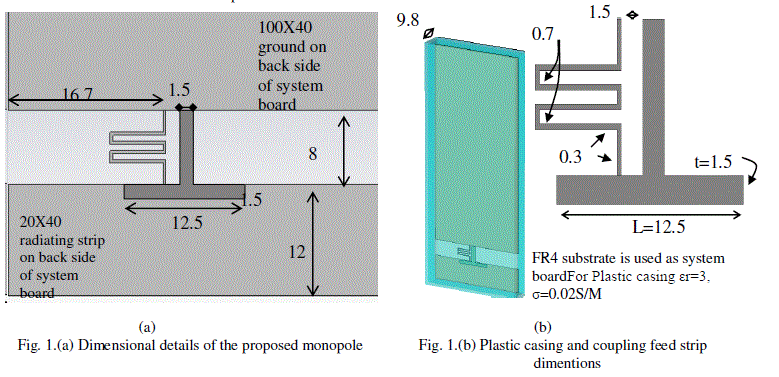 |
| The coupling-feed effect obtained here is different because of the use of the wide radiating plate in the proposed design, which is different from the long, narrow radiating strips. A short (8mm) coupling T-strip protruded from the ground plane gives a different coupling-feed effect in the proposed design from the use of long coupling-feed strips. |
| By including the use of the inductive shorting strip, a wide lower band to cover the frequency range of 698–960 MHz for the LTE-700, GSM-850, and LTE-900 operation can be generated. Effects of the inductive shorting strip on the generation of the antenna’s wide lower band are promising and should be selected properly to have desired bands. Also note that without the use of the wide radiating plate, that is, when the width of the radiating plate is decreased (the preferred width is 12 mm in this design), good impedance matching over the desired wide frequency range of 698–960 MHz cannot be achieved. |
| It easy to fine-tune the desired lower and upper bands for the antenna to cover the eight-band LTE/GSM/UMTS operation, because even there are large effects of the inductive shorting strip on the antenna’s lower band, the impedance matching for frequencies over the desired upper band of 1710–2690 MHz is relatively slightly affected. Moreover position of monopole has impact on generating the SAR. It is advantageous to place antenna at the bottom edge of the system board as this gives the required less SAR values. |
RESULTS |
| Fig. 2 shows the simulated return loss of the proposed antenna. The measured data agree with the simulated results obtained using CST MWS. With the -6dB S11 bandwidth definition, which is widely used as the design specification of the internal mobile phone antenna for WWAN communications, two wide operating bands are obtained. |
| The lower band shows a wide bandwidth of 480 MHz (690–1208 MHz), while the upper band has an even wider bandwidth of 1050 MHz (1670–2720 MHz). The wide lower and upper bands cover the LTE-700, GSM-850, GSM- 900 and GSM-1800, GSM-1900, UMTS, LTE-2300 and LTE-/2500 operation, respectively. |
| Fig. 3 shows the comparison of the simulated return loss for the proposed antenna, the case with a antenna at top of system board and the case with a antenna at bottom of the system board. From the results of two positions, a much similar bandwidth for both is seen. |
| Fig 4. Shows the simulated return loss as a function of length (L) of the coupling strip. It is obvious that as the length of coupling strip increases, lower bandwidth is not enough to cover the desired frequency bands. |
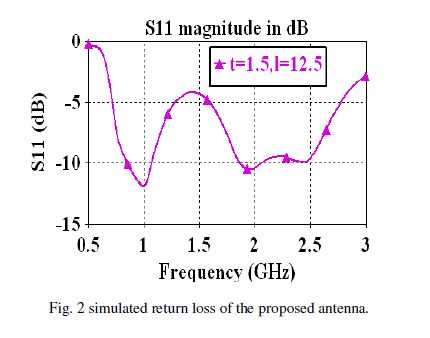 |
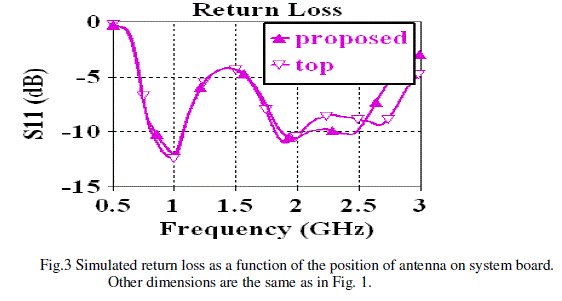 |
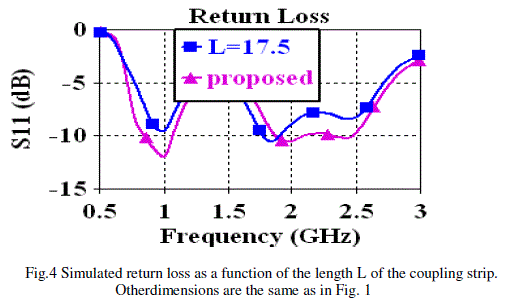 |
| Fig 5. Shows the simulated return loss as a function of width (t) of the coupling strip. It is obvious that as the width of coupling strip increases,lower band decreases |
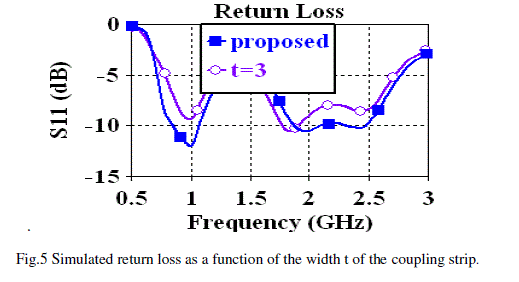 |
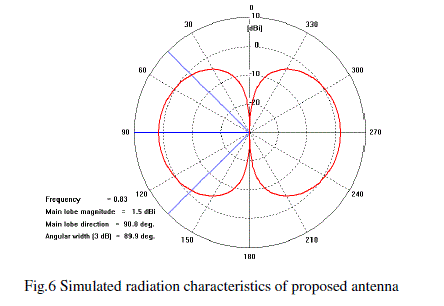 |
CONCLUSION |
| A planar monopole with a wide radiating strip energized by a coupling feed and short-circuited by an inductive metal strip has been shown to achieve low profile yet wideband operation for applications in the mobile phone to cover the eight-band LTE/GSM/UMTS operation. The proposed antenna can be in an all-printing structure or folded thin structure; both structures can provide two wide operating bands to cover the desired frequency ranges of 698–960 and 1710–2690 MHz. The obtained results indicate that the proposed antenna is suitable to be applied in the modern slim mobile phone for the eight-band LTE/GSM/UMTS operation. |
References |
|